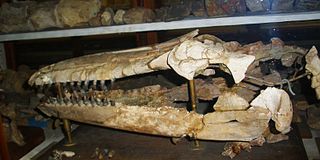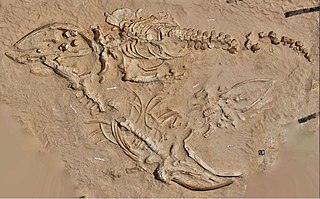
The genus Pygoscelis ("rump-legged") contains three living species of penguins collectively known as "brush-tailed penguins".

The banded penguins are penguins that belong to the genus Spheniscus. There are four living species, all with similar banded plumage patterns. They are sometimes also known as "jack-ass penguins" due to their loud locator calls sounding similar to a donkey braying. Common traits include a band of black that runs around their bodies bordering their black dorsal coloring, black beaks with a small vertical white band, distinct spots on their bellies, and a small patch of unfeathered or thinly feathered skin around their eyes and underdeveloped fluff sack that can be either white or pink. All members of this genus lay eggs and raise their young in nests situated in burrows or natural depressions in the earth.

Palaeospheniscus is an extinct genus of penguins belonging to the subfamily Palaeospheniscinae. These penguins are apparently not closely related to the modern genus Spheniscus.

Thalassocnus is an extinct genus of semiaquatic ground sloths from the Miocene and Pliocene of the Pacific South American coast. It is monotypic within the subfamily Thalassocninae. The five species—T. antiquus, T. natans, T. littoralis, T. carolomartini, and T. yuacensis—represent a chronospecies, a population gradually adapting to marine life in one direct lineage. They are the only known aquatic sloths, but they may have also been adapted to a terrestrial lifestyle. They have been found in the Pisco Formation of Peru, the Tafna Formation of Argentina, and the Bahía Inglesa, Coquimbo, and Horcón formations of Chile. Thalassocninae has been placed in both the families Megatheriidae and Nothrotheriidae.

Pelagornis is a widespread genus of prehistoric pseudotooth birds. These were probably rather close relatives of either pelicans and storks, or waterfowl, and are placed here in the order Odontopterygiformes to account for this uncertainty.
The South American land mammal ages (SALMA) establish a geologic timescale for prehistoric South American fauna beginning 64.5 Ma during the Paleocene and continuing through to the Late Pleistocene. These periods are referred to as ages, stages, or intervals and were established using geographic place names where fossil materials where obtained.
The Laventan age is a period of geologic time within the Middle Miocene epoch of the Neogene, used more specifically within the SALMA classification in South America. It follows the Colloncuran and precedes the Mayoan age.
The Chasicoan age is a period of geologic time from 10–9 Ma within the Late Miocene epoch of the Neogene, used more specifically within the SALMA classification in South America. It follows the Mayoan and precedes the Huayquerian age.

Livyatan is an extinct genus of macroraptorial sperm whale containing one known species: L. melvillei. The genus name was inspired by the biblical sea monster Leviathan, and the species name by Herman Melville, the author of the famous novel Moby-Dick about a white bull sperm whale. It is mainly known from the Pisco Formation of Peru during the Tortonian stage of the Miocene epoch, about 9.9–8.9 million years ago (mya); however, finds of isolated teeth from other locations such as Chile, Argentina, United States (California), South Africa and Australia imply that either it or a close relative survived into the Pliocene, around 5 mya, and may have had a global presence. It was a member of a group of macroraptorial sperm whales and was probably an apex predator, preying on whales, seals and so forth. Characteristically of raptorial sperm whales, Livyatan had functional, enamel-coated teeth on the upper and lower jaws, as well as several features suitable for hunting large prey.

Hemisyntrachelus is an extinct genus of cetacean.

Cerro Ballena is a fossiliferous locality of the Bahía Inglesa Formation, located in the Atacama Desert along the Pan-American Highway a few kilometers north of the port of Caldera, Chile. It has been dated back to the Late Miocene epoch, during the Neogene period. The locality was first noted in 1965 during military work and fully excavated and studied between 2011 and 2012, and is protected by law since the latter year.

The Pisco Formation is a geologic formation located in Peru, on the southern coastal desert of Ica and Arequipa. The approximately 640 metres (2,100 ft) thick formation was deposited in the Pisco Basin, spanning an age from the Middle Miocene up to the Early Pleistocene, roughly from 15 to 2 Ma. The tuffaceous sandstones, diatomaceous siltstones, conglomerates and dolomites were deposited in a lagoonal to near-shore environment, in bays similar to other Pacific South American formations as the Bahía Inglesa and Coquimbo Formations of Chile.
Caleta Herradura Formation is a geologic formation of Late Miocene (Montehermosan) age, cropping out on the Mejillones Peninsula in northern Chile. The erosion at the Coastal Cliff of northern Chile have created particularly good exposures of Caleta Herradura Formation. The formation deposited in a half graben within Mejillones Peninsula. The formation rests nonconformably on the Jorgino Formation.
Caldera Basin is a sedimentary basin located in the coast of northern Chile west of Copiapó. The basin has a fill of marine sediments of Late Cenozoic age. With a north-south extension of 43 kilometres (27 mi) and an east-west width of 20 kilometres (12 mi) the basin occupies an area between the coast and the Chilean Coast Range and between the port of Caldera and the mouth of Copiapó River. The sedimentary fill rests on metamorphic rocks of Paleozoic age and on plutonic rocks of Mesozoic age.

Brachydelphis is a genus of pontoporiid known from the Late Miocene Pisco Formation of Peru and the Bahía Inglesa Formation of Chile.

The Bahía Inglesa Formation is a littoral, sedimentary, and highly fossiliferous geological formation that outcrops across the nearby coastal zones of Caldera, Chile. The unit is part of the greater Caldera Basin and was deposited in deep-shallow water, littoral paleoenvironments. It holds an exquisite fossil record in several localities, mostly composed of marine mammals, as well as invertebrate taxa.

Spheniscus muizoni is an extinct species of banded penguins that lived during the early Late Miocene in what is now Peru, South America. The species, the earliest member of the extant genus, was described in 2007 by Ursula B. Göhlich based on fossils found in the fossiliferous Pisco Formation of the Pisco Basin, southwestern Peru.

The Gaiman Formation, in older literature also referred to as Patagonian Marine Formation, is a fossiliferous geologic formation of the Peninsula Valdés Basin in the eastern Chubut Province of northwestern Patagonia, eastern Argentina.

Spheniscus megaramphus is an extinct species of penguin that lived during the Late Miocene South America. It is notable for being the largest known species of banded penguin, along with having a proportionally large beak.

Spheniscus chilensis is an extinct species of penguin that lived during the Late Pliocene in Chile. The first fossil record of the penguin was discovered on the coast of Antofagasta in 1980, when coastal erosion exposed the first fossilized bone.















